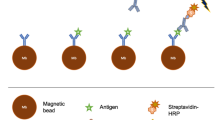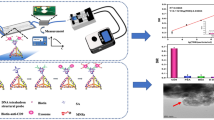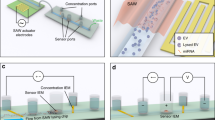Abstract
The performance of current microfluidic methods for exosome detection is constrained by boundary conditions, as well as fundamental limits to microscale mass transfer and interfacial exosome binding. Here, we show that a microfluidic chip designed with self-assembled three-dimensional herringbone nanopatterns can detect low levels of tumour-associated exosomes in plasma (10 exosomes μl−1, or approximately 200 vesicles per 20 μl of spiked sample) that would otherwise be undetectable by standard microfluidic systems for biosensing. The nanopatterns promote microscale mass transfer, increase surface area and probe density to enhance the efficiency and speed of exosome binding, and permit drainage of the boundary fluid to reduce near-surface hydrodynamic resistance, thus promoting particle–surface interactions for exosome binding. We used the device for the detection—in 2 μl plasma samples from 20 ovarian cancer patients and 10 age-matched controls—of exosome subpopulations expressing CD24, epithelial cell adhesion molecule and folate receptor alpha proteins, and suggest exosomal folate receptor alpha as a potential biomarker for early detection and progression monitoring of ovarian cancer. The nanolithography-free nanopatterned device should facilitate the use of liquid biopsies for cancer diagnosis.
This is a preview of subscription content, access via your institution
Access options
Access Nature and 54 other Nature Portfolio journals
Get Nature+, our best-value online-access subscription
$29.99 / 30 days
cancel any time
Subscribe to this journal
Receive 12 digital issues and online access to articles
$99.00 per year
only $8.25 per issue
Buy this article
- Purchase on Springer Link
- Instant access to full article PDF
Prices may be subject to local taxes which are calculated during checkout





Similar content being viewed by others
Data availability
The authors declare that all data supporting the findings of this study are available within the paper and its Supplementary Information files. The raw and analysed datasets generated during the study are available for research purposes from the corresponding author on reasonable request.
References
Schwarzenbach, H., Nishida, N., Calin, G. A. & Pantel, K. Clinical relevance of circulating cell-free microRNAs in cancer. Nat. Rev. Clin. Oncol. 11, 145–156 (2014).
Haber, D. A. & Velculescu, V. E. Blood-based analyses of cancer: circulating tumor cells and circulating tumor DNA. Cancer Discov. 4, 650–661 (2014).
He, M. & Zeng, Y. Microfluidic exosome analysis toward liquid biopsy for cancer. J. Lab. Autom. 21, 599–608 (2016).
Im, H. et al. Label-free detection and molecular profiling of exosomes with a nano-plasmonic sensor. Nat. Biotechnol. 32, 490–495 (2014).
Yanez-Mo, M. et al. Biological properties of extracellular vesicles and their physiological functions. J. Extracell. Vesicles 4, 27066 (2015).
Atay, S. et al. Oncogenic KIT-containing exosomes increase gastrointestinal stromal tumor cell invasion. Proc. Natl Acad. Sci. USA 111, 711–716 (2014).
Melo, S. A. et al. Glypican-1 identifies cancer exosomes and detects early pancreatic cancer. Nature 523, 177–182 (2015).
Zhang, P., He, M. & Zeng, Y. Ultrasensitive microfluidic analysis of circulating exosomes using a nanostructured graphene oxide/polydopamine coating. Lab Chip 16, 3033–3042 (2016).
Squires, T. M., Messinger, R. J. & Manalis, S. R. Making it stick: convection, reaction and diffusion in surface-based biosensors. Nat. Biotechnol. 26, 417–426 (2008).
Stroock, A. D. et al. Chaotic mixer for microchannels. Science 295, 647–651 (2002).
Shang, Y., Zeng, Y. & Zeng, Y. Integrated microfluidic lectin barcode platform for high-performance focused glycomic profiling. Sci. Rep. 6, 20297 (2016).
Kelley, S. O. et al. Advancing the speed, sensitivity and accuracy of biomolecular detection using multi-length-scale engineering. Nat. Nanotechnol. 9, 969–980 (2014).
Soleymani, L., Fang, Z., Sargent, E. H. & Kelley, S. O. Programming the detection limits of biosensors through controlled nanostructuring. Nat. Nanotechnol. 4, 844–848 (2009).
Bin, X., Sargent, E. H. & Kelley, S. O. Nanostructuring of sensors determines the efficiency of biomolecular capture. Anal. Chem. 82, 5928–5931 (2010).
Wang, S. et al. Three-dimensional nanostructured substrates toward efficient capture of circulating tumor cells. Angew. Chem. 48, 8970–8973 (2009).
Chen, G. D., Fachin, F., Fernandez-Suarez, M., Wardle, B. L. & Toner, M. Nanoporous elements in microfluidics for multiscale manipulation of bioparticles. Small. 7, 1061–1067 (2011).
Chen, G. D., Fachin, F., Colombini, E., Wardle, B. L. & Toner, M. Nanoporous micro-element arrays for particle interception in microfluidic cell separation. Lab Chip 12, 3159–3167 (2012).
Fachin, F., Chen, G. D., Toner, M. & Wardle, B. L. Integration of bulk nanoporous elements in microfluidic devices with application to biomedical diagnostics. J. Microelectromech. Syst. 20, 1428–1438 (2011).
Zeng, Y. & Harrison, D. J. Self-assembled colloidal arrays as three-dimensional nanofluidic sieves for separation of biomolecules on microchips. Anal. Chem. 79, 2289–2295 (2007).
Stott, S. L. et al. Isolation of circulating tumor cells using a microvortex-generating herringbone-chip. Proc. Natl Acad. Sci. USA 107, 18392–18397 (2010).
Wang, S. et al. Highly efficient capture of circulating tumor cells by using nanostructured silicon substrates with integrated chaotic micromixers. Angew. Chem. 50, 3084–3088 (2011).
Singh, G., Pillai, S., Arpanaei, A. & Kingshott, P. Multicomponent colloidal crystals that are tunable over large areas. Soft Matter 7, 3290–3294 (2011).
Nazemifard, N. et al. A systematic evaluation of the role of crystalline order in nanoporous materials on DNA separation. Lab Chip 12, 146–152 (2012).
Adams, A. A. et al. Highly efficient circulating tumor cell isolation from whole blood and label-free enumeration using polymer-based microfluidics with an integrated conductivity sensor. J. Am. Chem. Soc. 130, 8633–8641 (2008).
Forbes, T. P. & Kralj, J. G. Engineering and analysis of surface interactions in a microfluidic herringbone micromixer. Lab Chip 12, 2634–2637 (2012).
Sheng, W. et al. Capture, release and culture of circulating tumor cells from pancreatic cancer patients using an enhanced mixing chip. Lab Chip 14, 89–98 (2014).
Philipse, A. P. & Pathmamanoharan, C. Liquid permeation (and sedimentation) of dense colloidal hard-sphere packings. J. Colloid. Interface Sci. 159, 96–107 (1993).
Frishfelds, V., Hellstrom, J. G. I. & Lundstrom, T. S. Flow-induced deformations within random packed beds of spheres. Transport Porous Med. 104, 43–56 (2014).
Shao, H. et al. Chip-based analysis of exosomal mRNA mediating drug resistance in glioblastoma. Nat. Commun. 6, 6999 (2015).
Kanwar, S. S., Dunlay, C. J., Simeone, D. M. & Nagrath, S. Microfluidic device (ExoChip) for on-chip isolation, quantification and characterization of circulating exosomes. Lab Chip 14, 1891–1900 (2014).
He, M., Crow, J., Roth, M., Zeng, Y. & Godwin, A. K. Integrated immunoisolation and protein analysis of circulating exosomes using microfluidic technology. Lab Chip 14, 3773–3780 (2014).
Reategui, E. et al. Engineered nanointerfaces for microfluidic isolation and molecular profiling of tumor-specific extracellular vesicles. Nat. Commun. 9, 175 (2018).
Wan, Y. et al. Rapid magnetic isolation of extracellular vesicles via lipid-based nanoprobes.Nat. Biomed. Eng. 1, 0058 (2017).
Lobb, R. J. et al. Optimized exosome isolation protocol for cell culture supernatant and human plasma. J. Extracell. Vesicles 4, 27031 (2015).
Domcke, S., Sinha, R., Levine, D. A., Sander, C. & Schultz, N. Evaluating cell lines as tumour models by comparison of genomic profiles.Nat. Commun. 4, 2126 (2013).
Skog, J. et al. Glioblastoma microvesicles transport RNA and proteins that promote tumour growth and provide diagnostic biomarkers. Nat. Cell Biol. 10, 1470–1476 (2008).
Davies, R. T. et al. Microfluidic filtration system to isolate extracellular vesicles from blood. Lab Chip 12, 5202–5210 (2012).
Li, S., Zhao, J., Lu, P. & Xie, Y. Maximum packing densities of basic 3D objects. Chinese Sci. Bull. 55, 114–119 (2010).
Zhao, Z., Yang, Y., Zeng, Y. & He, M. A microfluidic ExoSearch chip for multiplexed exosome detection towards blood-based ovarian cancer diagnosis. Lab Chip 16, 489–496 (2016).
Chevillet, J. R. et al. Quantitative and stoichiometric analysis of the microRNA content of exosomes. Proc. Natl Acad. Sci. USA 111, 14888–14893 (2014).
Toffoli, G. et al. Overexpression of folate binding protein in ovarian cancers. Int. J. Cancer 74, 193–198 (1997).
Kurosaki, A. et al. Serum folate receptor alpha as a biomarker for ovarian cancer: implications for diagnosis, prognosis and predicting its local tumor expression. Int. J. Cancer 138, 1994–2002 (2016).
Leung, F., Dimitromanolakis, A., Kobayashi, H., Diamandis, E. P. & Kulasingam, V. Folate-receptor 1 (FOLR1) protein is elevated in the serum of ovarian cancer patients. Clin. Biochem. 46, 1462–1468 (2013).
Yang, J., Choi, M. K., Kim, D. H. & Hyeon, T. Designed assembly and integration of colloidal nanocrystals for device applications. Adv. Mater. 28, 1176–1207 (2016).
Kim, J., Li, Z. & Park, I. Direct synthesis and integration of functional nanostructures in microfluidic devices. Lab Chip 11, 1946–1951 (2011).
Jeon, S., Malyarchuk, V., White, J. O. & Rogers, J. A. Optically fabricated three dimensional nanofluidic mixers for microfluidic devices. Nano Lett. 5, 1351–1356 (2005).
Park, S. G., Lee, S. K., Moon, J. H. & Yang, S. M. Holographic fabrication of three-dimensional nanostructures for microfluidic passive mixing. Lab Chip 9, 3144–3150 (2009).
Hu, Y. et al. Laser printing hierarchical structures with the aid of controlled capillary-driven self-assembly. Proc. Natl Acad. Sci. USA 112, 6876–6881 (2015).
Cederquist, K. B. & Kelley, S. O. Nanostructured biomolecular detectors: pushing performance at the nanoscale. Curr. Opin. Chem. Biol. 16, 415–421 (2012).
Vogel, N., Retsch, M., Fustin, C. A., Del Campo, A. & Jonas, U. Advances in colloidal assembly: the design of structure and hierarchy in two and three dimensions. Chem. Rev. 115, 6265–6311 (2015).
Bast, R. C. Jr, Hennessy, B. & Mills, G. B. The biology of ovarian cancer: new opportunities for translation. Nat. Rev. Cancer 9, 415–428 (2009).
Bodurka, D. C. et al. Reclassification of serous ovarian carcinoma by a 2-tier system: a Gynecologic Oncology Group study. Cancer 118, 3087–3094 (2012).
Cheung, A. et al. Targeting folate receptor alpha for cancer treatment. Oncotarget 7, 52553–52574 (2016).
Kuijk, A., van Blaaderen, A. & Imhof, A. Synthesis of monodisperse, rodlike silica colloids with tunable aspect ratio. J. Am. Chem. Soc. 133, 2346–2349 (2011).
Kastelowitz, N. & Yin, H. Exosomes and microvesicles: identification and targeting by particle size and lipid chemical probes. ChemBioChem 15, 923–928 (2014).
Müllner, T., Unger, K. K. & Tallarek, U. Characterization of microscopic disorder in reconstructed porous materials and assessment of mass transport-relevant structural descriptors. New J. Chem. 40, 3993–4015 (2016).
Warnes, G. R. et al. gplots: Various R Programming Tools for Plotting Data v.3.0.1.1 (CRAN, 2019); https://cran.r-project.org/web/packages/gplots/index.html
Acknowledgements
We thank the microfabrication core facility at the KU COBRE Center for Molecular Analysis of Disease Pathways for device fabrication, and the KU Cancer Center’s Biospecimen Repository Core Facility, funded in part by the National Cancer Institute Cancer Center Support Grant (P30 CA168524) for providing clinical plasma samples, T. Meyer (KUMC) for technical support with immunohistochemistry, R. Madan (KUMC) for histopathology review, and H. Pathak (KUCC) for technical guidance with cell line-derived exosome isolations. This study was supported by 1R21CA186846, 1R21CA207816, 1R21EB024101, 1R33CA214333 and P20GM103638 from the NIH. P.Z. was supported by the postdoc award from the Kansas IDeA Network of Biomedical Research Excellence under the grant P20GM103418 from NIH/NIGMS. A.K.G. is the Chancellors Distinguished Chair in Biomedical Sciences Endowed Professor.
Author information
Authors and Affiliations
Contributions
Y.Z. conceived and supervised the project. P.Z. and Y.Z. designed the research. P.Z. performed the technology development, microfluidic analysis and microscopic imaging. X.Z. and P.Z. conducted mRNA profiling. M.H. contributed to numerical simulation. Y.S. isolated exosomes from clinical samples, and conducted western blot and some NTA analyses. A.L.T. isolated exosomes from cell culture media and helped with the immunohistochemistry. A.K.G. provided clinical samples and assisted in clinical studies. P.Z., X.Z., M.H., Y.S., A.K.G. and Y.Z. analysed the data. P.Z. and Y.Z. wrote the manuscript. All authors edited the manuscript.
Corresponding author
Ethics declarations
Competing interests
The authors declare no competing interests.
Additional information
Publisher’s note: Springer Nature remains neutral with regard to jurisdictional claims in published maps and institutional affiliations.
Supplementary information
Supplementary Information
Supplementary figures and tables.
Rights and permissions
About this article
Cite this article
Zhang, P., Zhou, X., He, M. et al. Ultrasensitive detection of circulating exosomes with a 3D-nanopatterned microfluidic chip. Nat Biomed Eng 3, 438–451 (2019). https://doi.org/10.1038/s41551-019-0356-9
Received:
Accepted:
Published:
Issue Date:
DOI: https://doi.org/10.1038/s41551-019-0356-9



